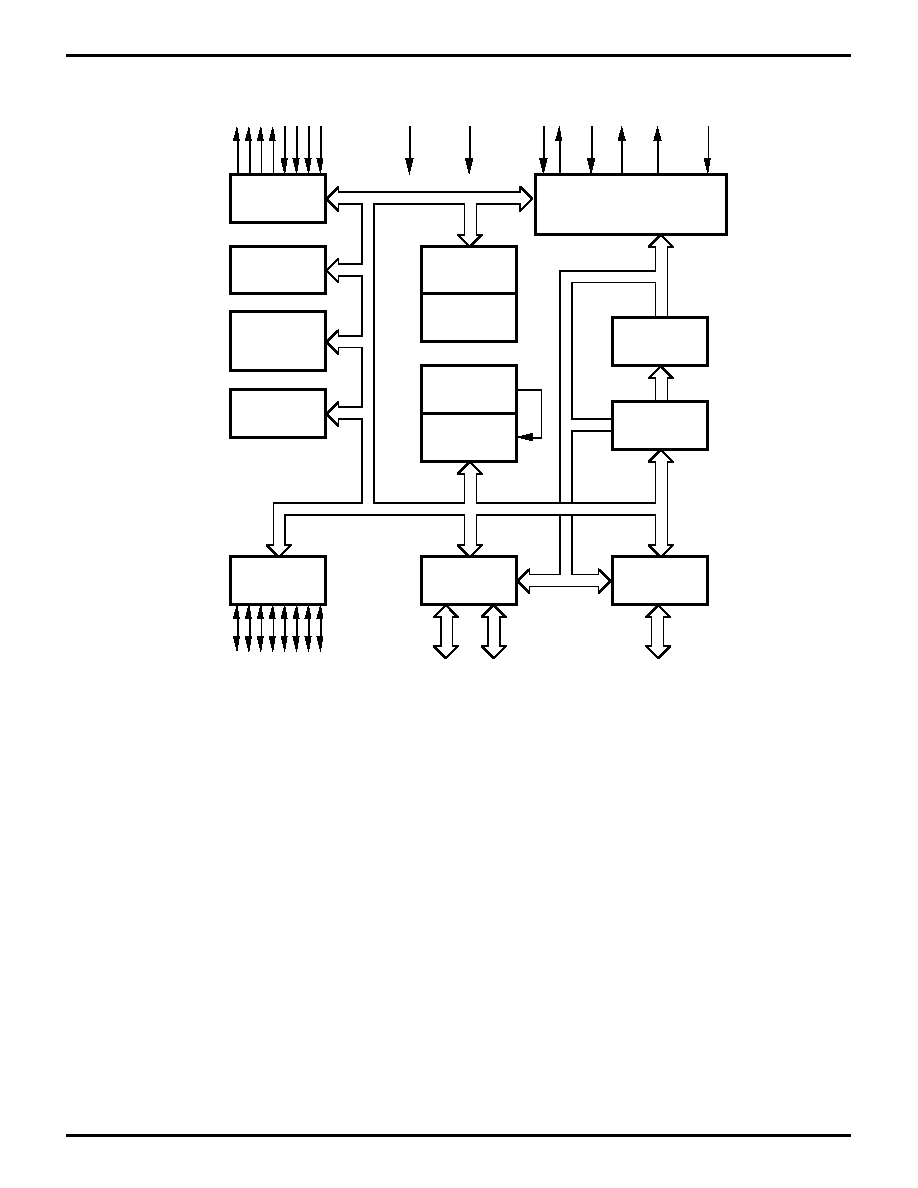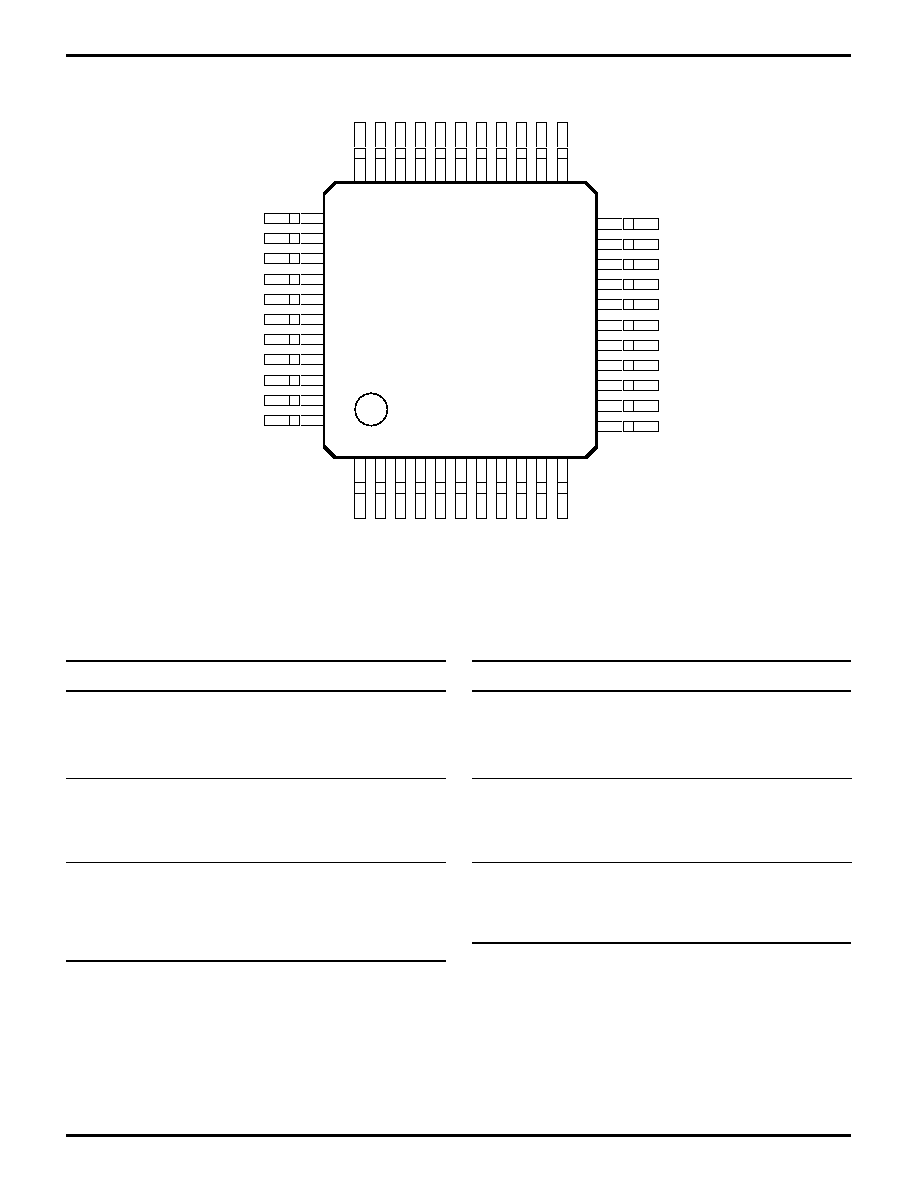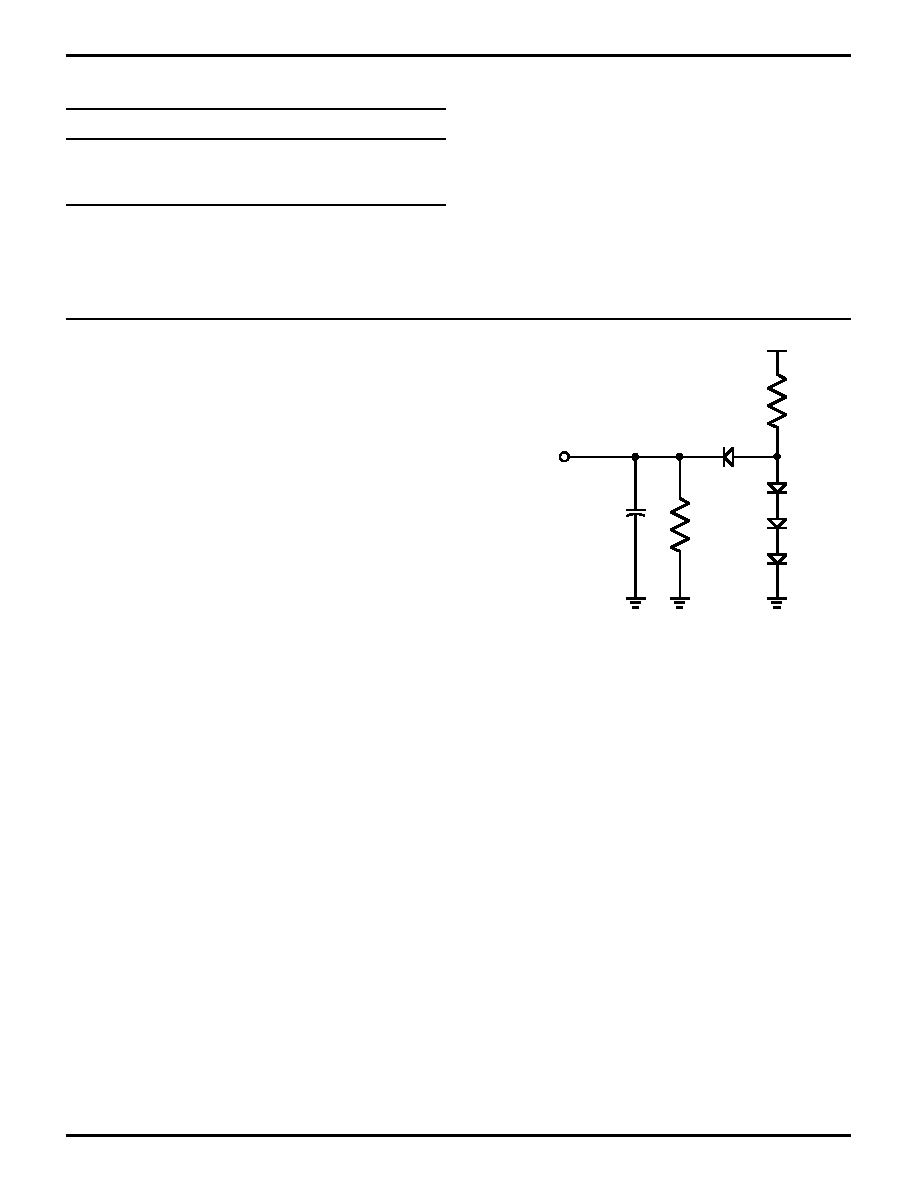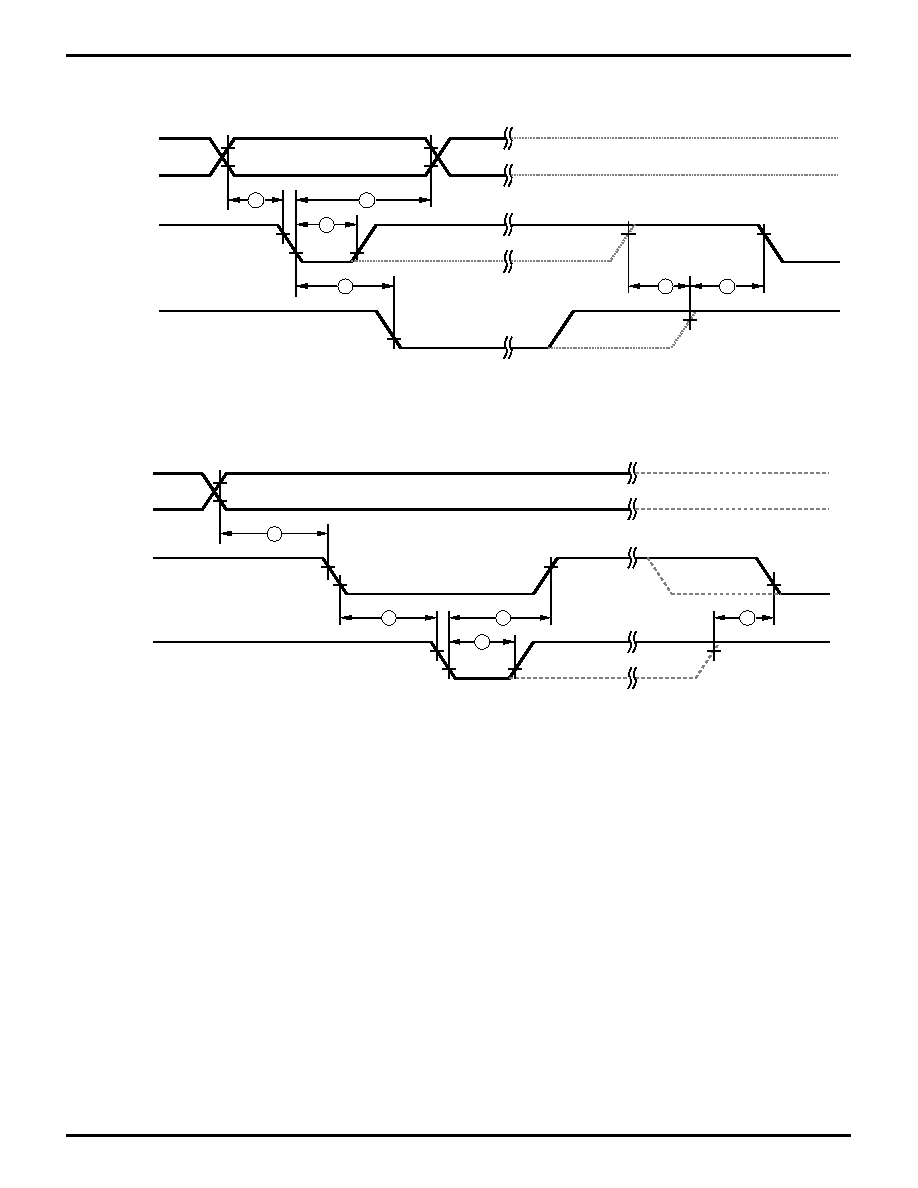 | –≠–ª–µ–∫—Ç—Ä–æ–Ω–Ω—ã–π –∫–æ–º–ø–æ–Ω–µ–Ω—Ç: Z86E21 | –°–∫–∞—á–∞—Ç—å:  PDF PDF  ZIP ZIP |

1
C
USTOMER
P
ROCUREMENT
S
PECIFICA
TION
Z86E21
CMOS Z8
Æ
OTP
M
ICROCONTROLLER
GENERAL DESCRIPTION
The Z86E21 microcontroller (MCU) introduces the next
level of sophistication to single-chip architecture. The
Z86E21 is a member of the Z8 single-chip microcontroller
family with 8 Kbytes of EPROM and 236 bytes of general
purpose RAM.
The Z86E21 is a pin compatible, One-Time-Programmable
(OTP) version of the Z86C21. The Z86E21 contains 8
Kbytes of EPROM memory in place of the 8 Kbyte of ROM
on the Z86C21.
The MCU is housed in a 40-pin DIP, 44-pin Leaded Chip-
Carrier, or a 44-pin Quad Flat Pack, and is manufactured
in CMOS technology. The ROMless pin option is available
on the 44-pin versions only. The MCU can address both
external memory and preprogrammed ROM which en-
ables this Z8 microcomputer to be used in high volume
applications or where code flexibility is required.
Zilog's CMOS microcontroller offers fast execution, effi-
cient use of memory, sophisticated interrupts, input/output
bit manipulation capabilities, and easy hardware/software
system expansion along with low cost and low power
consumption.
The Z86E21 architecture is based on Zilog's 8-bit
microcontroller core. The device offers a flexible I/O
scheme, an efficient register and address space structure,
multiplexed capabilities between address/data, I/O, and a
number of ancillary features that are useful in many indus-
trial and advanced scientific applications.
The device applications demand powerful I/O capabilities.
The Z86E21 fulfills this with 32-pin dedicated to input and
output. These lines are grouped into four ports. Each port
consists of eight lines, and is configurable under software
control to provide timing, status signals, serial or parallel
I/O with or without handshake, and an address/data bus
for interfacing external memory.
There are three basic address spaces available to support
this wide range of configuration: Program Memory, Data
Memory and 236 General-Purpose registers.
To unburden the program from coping with real-time
problems such as counting/timing and serial data commu-
nication, the Z86E21 offers two on-chip counter/timers with
a large number of user selectable modes, and an asyn-
chronous receiver/transmitter (UART) (see Functional Block
Description).
In ROM Protect Mode, the instructions LDC, LDCI, LDE
and LDEI are disabled when reading address locations
%0000 to %1FFF.
Notes:
All Signals with a preceding front slash, "/", are active Low, e.g.:
B//W (WORD is active Low); /B/W (BYTE is active Low, only).
Power connections follow conventional descriptions below:
Connection
Circuit
Device
Power
V
CC
V
DD
Ground
GND
V
SS
DC-2964-10
PRODUCT RECOMMENDATIONS
Zilog recommends the following programming equipment for use with this One-Time-Programmable product:
Recommended Revision Level
Device
Zilog Support Tool
Hardware
Software
Z86E21
Z86C1200ZEM ICEBOX
TM
Emulator*
(*Does not support 4K/8K option.)
B
1.5
Z86E21
Data I/O 3900 Programmer*
(*Does not support option bits.)
1.1
Z86E21
Data I/O Unisite Programmer*
(*Does not support option bits.)
3.7
Some non-Zilog programmers may have different pro-
gramming waveforms, voltages and timings and not all
programmers may meet the programming requirements of
Zilog's One-Time-Programmable products.
If difficulty is encountered in programming a Zilog OTP
product, please contact your local Zilog sales office.

2
GENERAL DESCRIPTION
(Continued)
Port 3
UART
Counter/
Timers
(2)
Interrupt
Control
Port 2
I/O
(Bit Programmable)
ALU
FLAGS
Register
Pointer
Register File
256 x 8-Bit
Machine Timing and
Instruction Control
Prg. Memory
8192 x 8-Bit
Program
Counter
Vcc
GND
XTAL
4
4
Port 0
Output
Input
Address or I/O
(Nibble Programmable)
8
Port 1
Address/Data or I/O
(Byte Programmable)
/AS /DS R//W /RESET
Functional Block Diagram

3
PIN DESCRIPTION
Standard Mode
40-Lead DIP Pin Assignments
40-Lead DIP Pin Identification
Pin #
Symbol
Function
Direction
1
V
CC
Power Supply
Input
2
XTAL2
Crystal, Oscillator Clock
Output
3
XTAL1
Crystal, Oscillator Clock
Input
4
P37
Port 3 pin 7
Output
5
P30
Port 3 pin 0
Input
6
/RESET
Reset
Input
7
R//W
Read/Write
Output
8
/DS
Data Strobe
Output
9
/AS
Address Strobe
Output
10
P35
Port 3 pin 5
Output
Pin #
Symbol
Function
Direction
11
GND
Ground, GND
Input
12
P32
Port 3 pin 2
Input
13-20
P00-P07
Port 0 pin 0,1,2,3,4,5,6,7 In/Output
21-28
P10-P17
Port 1 pin 0,1,2,3,4,5,6,7 In/Output
29
P34
Port 3 pin 4
Output
30
P33
Port 3 pin 3
Input
31-38
P20-P27
Port 2 pin 0,1,2,3,4,5,6,7 In/Output
39
P31
Port 3 pin 1
Input
40
P36
Port 3 pin 6
Output
1
2
9
3
4
5
6
7
8
40
39
38
37
36
35
34
33
32
P36
P31
P21
P27
P26
P25
P24
P23
P22
VCC
XTAL2
P37
P30
/RESET
R//W
/DS
31
30
29
28
27
14
10
11
12
13
XTAL1
GND
P32
P00
P01
P20
P33
P34
P17
P16
Z86E21
DIP
15
26
25
24
23
22
21
20
16
17
18
19
/AS
P35
P02
P03
P06
P07
P05
P04
P13
P15
P14
P12
P11
P10

4
PIN DESCRIPTION
(Continued)
Standard Mode
N/C
P30
P37
XTAL1
XTAL2
VCC
P36
P31
P27
P26
P25
P03
P04
P05
P06
P07
P10
P11
P12
P13
P14
N/C
N/C
P24
P23
P22
P21
P20
P33
P34
P17
P16
P15
/RESET
R//W
/DS
/AS
P35
GND
P32
P00
P01
P02
R//RL
7
8
9
10
11
12
13
14
15
16
17
38
37
36
35
34
33
32
31
30
29
39
Z86E21
PLCC
6
5
4
3
2
1
44 43 42 41 40
18 19 20 21 22 23 24 25 26 27 28
Pin #
Symbol
Function
Direction
14-16
P00-P02
Port 0 pin 0,1,2
In/Output
17
R//RL
ROM/ROMless control
Input
18-22
P03-P07
Port 0 pin 3,4,5,6,7
In/Output
23-27
P10-P14
Port 1 pin 0,1,2,3,4
In/Output
28
N/C
Not Connected
Input
29-31
P15-P17
Port 1 pin 5,6,7
In/Output
32
P34
Port 3 pin 4
Output
33
P33
Port 3 pin 3
Input
34-38
P20-P24
Port 2 pin 0,1,2,3,4
In/Output
39
N/C
Not Connected
Input
40-42
P25-P27
Port 2 pin 5,6,7
In/Output
43
P31
Port 3 pin 1
Input
44
P36
Port 3 pin 6
Output
Pin #
Symbol
Function
Direction
1
V
CC
Power Supply
Input
2
XTAL2
Crystal, Oscillator Clock
Output
3
XTAL1
Crystal, Oscillator Clock
Input
4
P37
Port 3 pin 7
Output
5
P30
Port 3 pin 0
Input
6
N/C
Not Connected
Input
7
/RESET
Reset
Input
8
R//W
Read/Write
Output
9
/DS
Data Strobe
Output
10
/AS
Address Strobe
Output
11
P35
Port 3 pin 5
Output
12
GND
Ground, GND
Input
13
P32
Port 3 pin 2
Input
44-Lead PLCC Pin Assignments
44-Lead PLCC Pin Identification

5
34
35
36
37
38
39
40
41
42
43
44
21
20
19
18
17
16
15
14
13
12
22
33 32 31 30 29 28 27 26 25 24 23
1
2
3
4
5
6
7
8
9
10
11
GND
P30
P37
XTAL1
XTAL2
VCC
P36
P31
P27
P26
P25
/RESET
R//W
/DS
/AS
P35
GND
P32
P00
P01
P02
R//RL
GND
P24
P23
P22
P21
P20
P33
P34
P17
P16
P15
P03
P04
P05
P06
P07
P10
P11
P12
P13
P14
GND
Z86E21
QFP
44-Lead QFP Pin Identification
Pin #
Symbol
Function
Direction
1-5
P03-P07
Port 0 pin 3,4,5,6,7
In/Output
6
GND
Ground, GND
Input
7-14
P10-P17
Port 1 pin 0,1,2,3,4,5,6,7
In/Output
15
P34
Port 3 pin 4
Output
16
P33
Port 3 pin 3
Input
17-21
P20-P24
Port 2 pin 0,1,2,3,4
In/Output
22
GND
Ground, GND
Input
23-25
P25-P27
Port 2 pin 5,6,7
In/Output
26
P31
Port 3 pin 1
Input
27
P36
Port 3 pin 6
Output
28
GND
Ground, GND
Input
29
V
CC
Power Supply
Input
30
XTAL2
Crystal, Oscillator Clock
Output
Pin #
Symbol
Function
Direction
31
XTAL1
Crystal, Oscillator Clock
Input
32
P37
Port 3 pin 7
Output
33
P30
Port 3 pin 0
Input
34
/RESET
Reset
Input
35
R//W
Read/Write
Output
36
/DS
Data Strobe
Output
37
/AS
Address Strobe
Output
38
P35
Port 3 pin 5
Output
39
GND
Ground, GND
Input
40
P32
Port 3 pin 2
Input
41-43
P00-P02
Port 0 pin 0,1,2
In/Output
44
R//RL
ROM/ROMless control
Input
44-Lead QFP Pin Assignments

6
Stresses greater than those listed under Absolute Maxi-
mum Ratings may cause permanent damage to the de-
vice. This is a stress rating only; operation of the device at
any condition above those indicated in the operational
sections of these specifications is not implied. Exposure to
absolute maximum rating conditions for an extended pe-
riod may affect device reliability.
STANDARD TEST CONDITIONS
The characteristics listed below apply for standard test
conditions as noted. All voltages are referenced to GND.
Positive current flows into the referenced pin (Test Load
Diagram).
ABSOLUTE MAXIMUM RATINGS
Symbol Description
Min
Max Units
V
CC
Supply Voltage*
-0.3
+7.0
V
T
STG
Storage Temp
-65
+150
C
T
A
Oper Ambient Temp
C
Notes:
* Voltages on all pins with respect to GND.
13.0 V Maximum on P30-P33.
See Ordering Information
+5V
From Output
Under Test
9.1 k
2.1 k
150 pF
Test Load Diagram

7
DC CHARACTERISTICS
T
A
= 0
∞
C
T
A
= -40
∞
C
to +70
∞
C to +105
∞
C
Typical
Sym. Parameter
Min
Max
Min
Max
@ 25
∞
C Units
Conditions
Max Input Voltage
7
7
V
I
IN
250
µ
A
Max Input Voltage
13
13
V
P30-P33 Only
V
CH
Clock Input High Voltage
3.8
V
CC
3.8
V
CC
V
Driven by External Clock Generator
V
CL
Clock Input Low Voltage
-0.03
0.8
-0.03
0.8
V
Driven by External Clock Generator
V
IH
Input High Voltage
2.0
V
CC
2.0
V
CC
V
V
IL
Input Low Voltage
-0.3
0.8
-0.3
0.8
V
V
OH
Output High Voltage
2.4
2.4
V
I
OH
= -2.0 mA
V
OL
Output Low Voltage
0.4
0.4
V
I
OL
= +2.0 mA
V
RH
Reset Input High Voltage
3.8
V
CC
3.8
V
CC
V
V
Rl
Reset Input Low Voltage
-0.03
0.8
-0.03
0.8
V
I
IL
Input Leakage
-10
10
-10
10
µ
A
0V V
IN
+5.25V
I
OL
Output Leakage
-10
10
-10
10
µ
A
0V V
IN
+5.25V
I
IR
Reset Input Current
-50
-50
µ
A
V
CC
= +5.25V, V
RL
= 0V
I
CC
Supply Current
50
50
25
mA
@ 12 MHz
60
60
35
mA
@ 16 MHz
I
CC1
Standby Current
15
15
5
mA
HALT Mode V
IN
= OV, V
CC
@ 12 MHz
20
20
10
mA
HALT Mode V
IN
= OV, V
CC
@ 16 MHz
I
CC2
Standby Current
20
20
5
µ
A
STOP Mode V
IN
= OV, V
CC
@ 12 MHz
20
20
5
µ
A
STOP Mode V
IN
= OV, V
CC
@ 16 MHz
Notes:
I
CC2
requires loading TMR (%F1H) with any value prior to STOP execution.
Use this sequence:
LD TMR,#00
NOP

8
R//W
9
12
19
3
16
13
4
5
8
18
11
6
17
10
15
7
14
2
1
Port 0, /DM
Port 1
/AS
/DS
(Read)
Port 1
/DS
(Write)
A - A
0
7
D - D IN
0
7
D - D OUT
0
7
A - A
0
7
External I/O or Memory Read/Write Timing
AC CHARACTERISTICS
External I/O or Memory Read or Write Timing Diagram

9
AC CHARACTERISTICS
External I/O or Memory Read and Write Timing Table
T
A
= 0
∞
C to 70
∞
C
T
A
= -40
∞
C to 105
∞
C
12 MHz 16 MHz 12 MHz 16 MHz
No Symbol
Parameter
Max Min Max Min Max Min Max Min Units Notes
1
TdA(AS)
Address Valid to /AS Rise Delay
35
20
35
25
ns
[2,3]
2
TdAS(A)
/AS Rise to Address Float Delay
45
30
45
35
ns
[2,3]
3
TdAS(DR)
/AS Rise to Read Data Req'd Valid
220
180
250
180
ns
[1,2,3]
4
TwAS
/AS Low Width
55
35
55
40
ns
[2,3]
5
TdAZ(DS)
Address Float to /DS Fall
0
0
0
0
ns
6
TwDSR
/DS (Read) Low Width
185
135
185
135
ns
[1,2,3]
7
TwDSW
/DS (Write) Low Width
110
80
110
80
ns
[1,2,3]
8
TdDSR(DR)
/DS Fall to Read Data Req'd Valid
130
75
130
75
ns
[1,2,3]
9
ThDR(DS)
Read Data to /DS Rise Hold Time
0
0
0
0
ns
[2,3]
10
TdDS(A)
/DS Rise to Address Active Delay
45
35
65
50
ns
[2,3]
11
TdDS(AS)
/DS Rise to /AS Fall Delay
55
30
45
35
ns
[2,3]
12
TdR/W(AS)
R//W Valid to /AS Rise Delay
30
20
33
25
ns
[2,3]
13
TdDS(R/W)
/DS Rise to R//W Not Valid
35
30
50
35
ns
[2,3]
14
TdDW(DSW) Write Data Valid to /DS Fall (Write) Delay
35
25
35
25
ns
[2,3]
15
TdDS(DW)
/DS Rise to Write Data Not Valid Delay
35
30
55
35
ns
[2,3]
16
TdA(DR)
Address Valid to Read Data Req'd Valid
255
200
310
230
ns
[1,2,3]
17
TdAS(DS)
/AS Rise to /DS Fall Delay
55
40
65
45
ns
[2,3]
18
TdDI(DS)
Data Input Setup to /DS Rise
75
60
75
60
ns
[1,2,3]
19
TdDM(AS)
/DM Valid to /AS Fall Delay
50
30
50
30
ns
[2,3]
Clock Dependent Formulas
Number
Symbol
Equation
1
TdA(AS)
0.40TpC + 0.32
2
TdAS(A)
0.59TpC - 3.25
3
TdAS(DR)
2.38TpC + 6.14
4
TwAS
0.66TpC - 1.65
6
TwDSR
2.33TpC - 10.56
7
TwDSW
1.27TpC + 1.67
8
TdDSR(DR)
1.97TpC - 42.5
10
TdDS(A)
0.8TpC
11
TdDS(AS)
0.59TpC - 3.14
12
TdR/W(AS)
0.4TpC
13
TdDS(R/W)
0.8TpC - 15
14
TdDW(DSW)
0.4TpC
15
TdDS(DW)
0.88TpC - 19
16
TdA(DR)
4TpC - 20
17
TdAS(DS)
0.91TpC - 10.7
18
TsDI(DS)
0.8TpC - 10
19
TdDM(AS)
0.9TpC - 26.3
Notes:
[1] When using extended memory timing add 2 TpC.
[2] Timing numbers given are for minimum TpC.
[3] See clock cycle dependent characteristics table.
Standard Test Load
All timing references use 2.0V for a logic 1 and 0.8V for a logic 0.

10
AC CHARACTERISTICS
Additional Timing Diagram
Clock
1
3
4
5
2
2
3
T
IRQ
IN
N
Additional Timing
AC CHARACTERISTICS
Additional Timing Table
T
A
= 0
∞
C to 70
∞
C
T
A
= -40
∞
C to 105
∞
C
12 MHz 16 MHz 12 MHz 16 MHz
No Symbol
Parameter
Max Min Max Min Max Min Max Min Units Notes
1
TpC
Input Clock Period
83
1000
62.5
1000
83
1000
62.5
1000
ns
[1]
2
TrC,TfC
Clock Input Rise & Fall Times
15
10
15
10
ns
[1]
3
TwC
Input Clock Width
37
21
37
21
ns
[1]
4
TwTinL
Timer Input Low Width
75
50
75
50
ns
[2]
5
TwTinH
Timer Input High Width
3TpC
3TpC
3TpC
3TpC
[2]
6
TpTin
Timer Input Period
8TpC
8TpC
8TpC
8TpC
[2]
7
TrTin,TfTin
Timer Input Rise & Fall Times
100
100
100
100
ns
[2]
8A
TwIL
Interrupt Request Input Low Times
70
50
70
50
ns
[2,4]
8B
TwIL
Interrupt Request Input Low Times
3TpC
3TpC
3TpC
3TpC
[2,5]
9
TwIH
Interrupt Request Input High Times
3TpC
3TpC
3TpC
3TpC
[2,3]
Notes:
[1] Clock timing references use 3.8V for a logic 1 and 0.8V for a logic 0.
[2] Timing references use 2.0V for a logic 1 and 0.8V for a logic 0.
[3] Interrupt references request via Port 3.
[4] Interrupt request via Port 3 (P31-P33).
[5] Interrupt request via Port 30.

11
AC CHARACTERISTICS
Handshake Timing Diagrams
Data In
1
2
3
4
5
6
/DAV
(Input)
RDY
(Output)
Next Data In Valid
Delayed RDY
Delayed DAV
Data In Valid
Input Handshake Timing
Data Out
/DAV
(Output)
RDY
(Input)
Next Data Out Valid
Delayed RDY
Delayed DAV
Data Out Valid
7
8
9
10
11
Output Handshake Timing

12
AC CHARACTERISTICS
Handshake Timing Table
T
A
= 0
∞
C to 70
∞
C
T
A
= -40
∞
C to 105
∞
C
12 MHz
16 MHz
12 MHz
16 MHz
Data
No
Symbol
Parameter
Max
Min
Max
Min
Max
Min
Max
Min
Direction
1
TsDI(DAV)
Data In Setup Time
0
0
0
0
IN
2
ThDI(DAV)
Data In Hold Time
145
145
145
145
IN
3
TwDAV
Data Available Width
110
110
110
110
IN
4
TdDAVI(RDY)
DAV Fall to RDY Fall Delay
115
115
115
115
IN
5
TdDAVId(RDY)
DAV Rise to RDY Rise Delay
115
115
115
115
IN
6
TdDO(DAV)
RDY Rise to DAV Fall Delay
0
0
0
0
IN
7
TcLDAV0(RDY)
Data Out to DAV Fall Delay
TpC
TpC
TpC
TpC
OUT
8
TcLDAV0(RDY)
DAV Fall to RDY Fall Delay
0
0
0
0
OUT
9
TdRDY0(DAV)
RDY Fall to DAV Rise Delay
115
115
115
115
OUT
10
TwRDY
RDY Width
110
110
110
110
OUT
11
TdRDY0d(DAV)
RDY Rise to DAV Fall Delay
115
115
115
115
OUT
Zilog's products are not authorized for use as critical compo-
nents in life support devices or systems unless a specific written
agreement pertaining to such intended use is executed between
the customer and Zilog prior to use. Life support devices or
systems are those which are intended for surgical implantation
into the body, or which sustains life whose failure to perform,
when properly used in accordance with instructions for use
provided in the labeling, can be reasonably expected to result in
significant injury to the user.
Zilog, Inc. 210 East Hacienda Ave.
Campbell, CA 95008-6600
Telephone (408) 370-8000
Telex 910-338-7621
FAX 408 370-8056
Internet: http://www.zilog.com
© 1995 by Zilog, Inc. All rights reserved. No part of this document
may be copied or reproduced in any form or by any means
without the prior written consent of Zilog, Inc. The information in
this document is subject to change without notice. Devices sold
by Zilog, Inc. are covered by warranty and patent indemnification
provisions appearing in Zilog, Inc. Terms and Conditions of Sale
only. Zilog, Inc. makes no warranty, express, statutory, implied or
by description, regarding the information set forth herein or
regarding the freedom of the described devices from intellectual
property infringement. Zilog, Inc. makes no warranty of mer-
chantability or fitness for any purpose. Zilog, Inc. shall not be
responsible for any errors that may appear in this document.
Zilog, Inc. makes no commitment to update or keep current the
information contained in this document.











